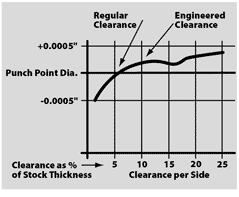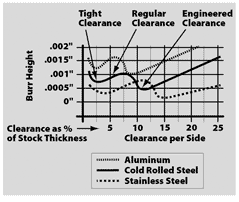The effects of stress, clearance and material
Perforating is defined as a process of making a hole by removing a slug. During perforating in a stamping operation, a punch shears and breaks a slug out of the part material and then pushes the slug into a matrix (die bushing). The matrix hole is larger than the punch point. A clearance must be maintained constantly around the entire punch point.
To perforate the part material, the material must fail. The harder the part material, the greater the forces on the punch and matrix become, resulting in sudden shock, excessive wear, high compressive loading, and fatigue-related failures.
During impact and penetration, the cutting edges on both the punch and matrix are subject to extreme pressure, which can result in chipping, heavy wear, and eventual breakage.
During snap-through, the sudden unloading of pressure on the punch generates a reverse shock that often leads to punch head breakage.
When the press ram reaches the bottom of its stroke, the punch should enter the matrix only about 0.020 to 0.030 inch. Overentry of the punch creates excessive wear and can cause slug pulling. The farther a punch enters, the more vacuum it creates at withdrawal. This vacuum can pull slugs.
Withdrawal of the punch from the part material can account for as much as two-thirds of punch wear and may be responsible for slug pulling.
Alleviating Pressure With Correct Clearance
Punch-to-matrix clearance can be described in two ways-total clearance and clearance per side (i). Both are correct; however, to minimize confusion, this article uses clearance per side as the standard.
Clearance per side is the distance between the cutting edges of the punch and the matrix. This distance is maintained around the entire perimeter of the cutting edges regardless of their shape.

For many years toolmakers used 5 percent of stock thickness per side as a standard, or regular, punch-to-die clearance. This provided an acceptable burr height and slug control. Research and testing have revealed that a radical increase in punch-to-matrix clearance can reduce burr height to the lowest point and increase tool life exponentially. This increased clearance is referred to as engineered clearance.
The side effect of this approach is slug pulling. When punch-to-matrix clearance is increased, the size of the slug is reduced. This leaves it loose and free to pull up at withdrawal. A spring-loaded ejector pin extending from the center of the punch face will remedy the slug pulling in most cases by pushing the slug free of the punch face. Or instead of the ejector pin, pressurized air blown through an air hole in the center of the punch pushes the slug free. Engineered clearance can be applied as long as there is a means of slug control.
Because regular clearance can produce a hole that is as much as 0.002 inch smaller than the point of the punch, it creates a press-fit condition on the point of the punch with every hit during withdrawal, causing excessive abrasive wear on both punch and matrix. An engineered clearance produces a hole that is larger than the point of the punch, leaving a slip-fit condition and eliminating as much as two-thirds of the wear incurred with regular clearance.
Characteristics of a Hole
 Hole characteristics vary with different clearances. Regular clearance typically results in a high percentage of shear or burnish with minimal rollover and break. The hole tends to be smaller than the punch point. Engineered clearance achieves a low percentage of shear or burnish, with greater rollover and break. The hole size with engineered clearance will be larger than the point of the punch.
Hole characteristics vary with different clearances. Regular clearance typically results in a high percentage of shear or burnish with minimal rollover and break. The hole tends to be smaller than the punch point. Engineered clearance achieves a low percentage of shear or burnish, with greater rollover and break. The hole size with engineered clearance will be larger than the point of the punch.
A comparison of holes perforated with regular clearance versus holes perforated using engineered clearance reveals the advantage of increasing clearance between the punch and matrix. As punch-to-matrix clearance increases, the hole size in relation to punch point size becomes larger, reducing stripping friction and wear. The result is longer punch life.
 Burr height also is affected by punch-to-matrix clearance. Regular clearance produces acceptable burrs in many cases. As the clearance increases, the burr height Increases. A substantial increase in punch-to-matrix clearance reduces the burr height below that produced with regular clearance in most applications.
Burr height also is affected by punch-to-matrix clearance. Regular clearance produces acceptable burrs in many cases. As the clearance increases, the burr height Increases. A substantial increase in punch-to-matrix clearance reduces the burr height below that produced with regular clearance in most applications.
Because the burr height initially gets worse before dropping to its lowest point with an engineered clearance, a compromise between regular and engineered clearance is not recommended.
Material Considerations
Type
Soft materials such as aluminum, brass, and draw-quality cold-rolled steels generally run best between 9 and 11 percent clearance per side. Low-carbon cold-rolled and hot-rolled, pickled and oiled steels, CDA 110 copper, and hardened brass tend to run best at about 12 or 13 percent clearance per side. Higher carbon spring steel and annealed stainless steel run best at 14 percent per side. Hardened materials require additional punch-to-matrix clearance.
Strength
Optimal clearance for a part depends on that material’s tensile and yield strengths. The higher the tensile and yield strength, the greater the recommended punch-to-matrix clearance. The greater the difference between the tensile and yield strengths, the greater the burr will be regardless of the clearance being used.
Snap-through shock has a direct relationship to material hardness. Harder and stronger materials generate the greatest shock. Once the slug has broken free, the direction of part material springback should be examined. With regular clearance, the hole in the part contracts and grabs the end of the punch. The slug expands and becomes jammed in the matrix.
The opposite reaction occurs when engineered clearance is applied, which minimizes potential slug jamming problems. A hole in the side of the punch vents the vacuum pocket, allowing the ejector pin to push the slug away without resistance.
Thickness
Part material thickness should also be taken into consideration when determining optimal punch-to-matrix clearance. Heavy-gauge material (more than ¼ in. thick) tends to benefit from an additional 1 or 2 percent of clearance per side to reduce the chance of double break and slivers in the die.
Thin materials (less than 0.020 in. thick) create the greatest challenge for determining optimal punch-to-matrix clearance. These clearances can be radically higher than what is traditionally used. It is not uncommon for aluminum to run best at 15 to 20 percent clearance per side and for spring steel and stainless to exceed 25 percent clearance per side.
A general practice in designing and building a stamping tool is to apply a common punch-to-matrix clearance to all of the perforated holes regardless of size. Unfortunately, there comes a point when a hole size becomes too small in relation to the part material thickness for that clearance to be effective. This results in higher punch loading, longer burnish in the hole, and excessive burr.
This phenomenon begins to occur when the hole size drops below 1½ times the part material thickness. At that point it becomes more difficult to bend and cleanly break the slug free.
Increased leverage to bend and break the slug can be achieved by increasing the punch-to-matrix clearance. One percent clearance per side should be added to the existing clearance when the hole size is 1½ times the part material thickness and increased more as the hole size becomes smaller in relation to the material thickness. A hole size that is equal to the part material thickness needs approximately 4 percent additional clearance per side.
The resulting hole from a nearly 1:1 ratio of punch point diameter to material thickness will have different characteristics than a larger-diameter hole in the same part. Small holes that are less than 1½ times the material thickness have a longer burnish length, larger burr, and tend to be smaller than the point of the punch point size. Slug burnish and break are affected in much the same manner as the hole is.
The slug becomes difficult to bend and break out of the part when the diameter is less than 1½ times the material thickness. This increases load and forces the punch and matrix to cut a greater portion of the slug before it breaks free, resulting in excessive galling, wear, slug jamming, and punch breakage.
The bottom line is, when the objective is to achieve a high percentage of shear or burnish in one hit, or to have a very short production run, regular clearance may be suitable. However, in all other circumstances, engineered punch-to-matrix clearance should be a strong consideration.

